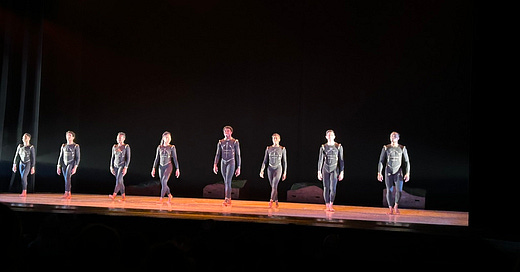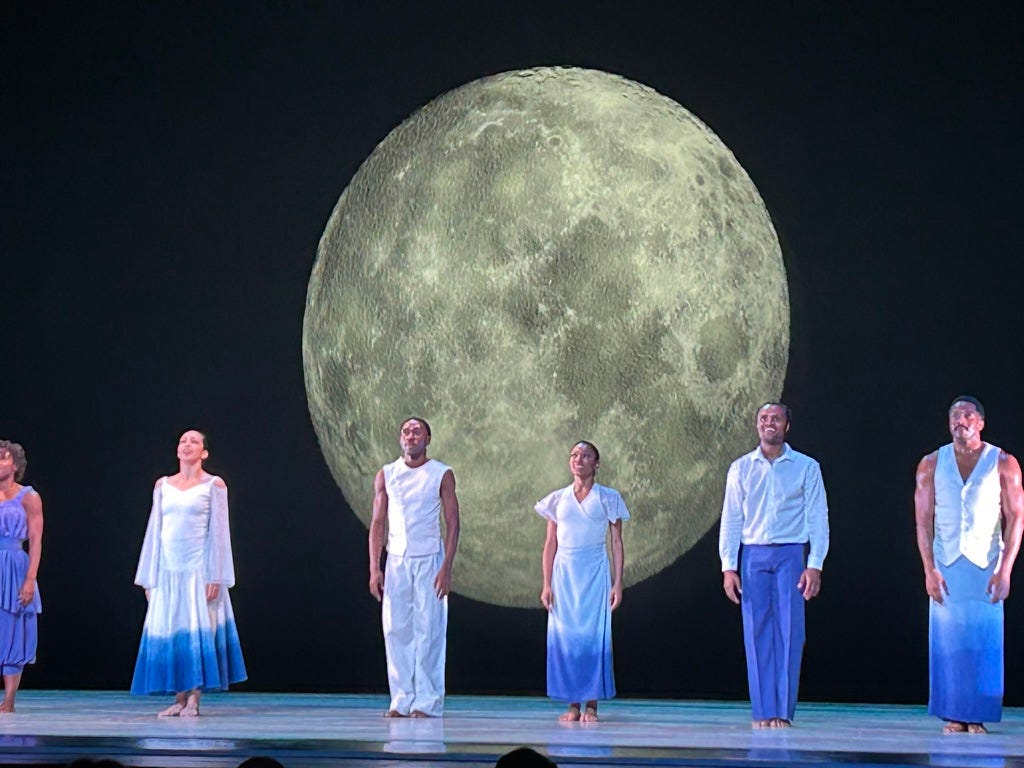Spirit Quest
Jamar Roberts's new "Al-Andalus Blues" and Ronald K. Brown's "Dancing Spirit" at Alvin Ailey American Dance T
The cast of Jamar Roberts’s new “Al-Andalus Blues”
I’ve been a fan of Jamar Roberts’s work since his 2017 “Members Don’t Get Weary” for Alvin Ailey. In particular, I admire his musicality—he’s partial to complex jazz—and his ability to sublimate stories and meaning through movement. And he draws exceptionally committed, un-fussy performances from his dancers. So I was looking forward to the new “Al-Andalus Blues,” his latest for the Ailey troupe. After seeing the premiere, though, I confess to finding it frustratingly opaque. The inspiration, it has been written, is the centuries-long Moorish rule of the Iberian peninsula, prior to the catholic takeover (or Reconquista), completed in 1492. It is an excitingly fertile subject. And the musical choices, a recording of Roberta Flack singing “Angelitos Negros,” based on a poem by the Venezuelan poet Andrés Eloy Blanco, and Miles Davis’s version of “Concierto de Aranjuez,” are evocative. But what to make of this dance for an ensemble of what appear to be medieval knights, dressed in what looks like armor, with crosses inscribed on their chests? Are they meant to represent the conquistadores, marching into Al-Andalus? They move like warriors, with intensity and purpose, led by the highly expressive Hannah Alissa Richardson. Arms slice and jab, bodies twist and curve furiously. Two men fight to the death. A platform (by Libby Stadstad) is pulled apart—does this represent the kingdom of Al Andalus being torn asunder? The stakes are high, but which side of the story is being told? While this happens, we hear Miles Davis’s endless modulations on Joaquín Rodrigo’s melodies, familiar from countless guitar concerts. But the marriage of music and dance never happens; in fact the two elements are mostly at cross purposes. One is fervent, the other exploratory; one meanders, the other drives toward something, though that goal is unclear. And so, despite the intensity of the performances, the piece drags, and we never really understand what it’s all about.
The cast of Ronald K. Brown's "Dancing Spirit.”
Brown created “Dancing Spirit” in 2009, as a tribute to Judith Jamison; he even borrowed the title of her memoir. There are other little borrowings in the piece as well, including an evocation of "Cry," Ailey's 1971 solo for Jamison, in which she embodied the labor and love intrinsic to the lives Black women everywhere, "especially," as Ailey put it, "our mothers." (Here this passage is danced by the lyrical Daley-Perdomo). "Dancing Spirit" is one of Brown's quietest, sparest, most inward works, set to mostly quiet music: a gentle xylophone melody, a passage for guitar, another for saxophone. (The composers include Duke Ellington, Wynton Marsalis, and Radiohead.) The dancers never look out at the audience. Instead, they dance for each other, or themselves, or the universe. The dance begins with a slow procession, led by Daley-Perdomo in which one after another, the dancers enter, moving their arms down, up, outward, and forward. It becomes an incantation. Later, an overlapping phrase is introduced, led by Chalvar Monteiro, in which he slaps the air with his arm, sharply, creating a new layer of rhythm. (The layering of rhythms is one of Brown's special talents.) Monteiro and Daley-Perdomo, lead spirits, share a gorgeous duet of turns and arabesques. Gradually the stage fills with dancers, each engrossed in his or her own world, alone or joined by a few companions. They are like planets, each on its own orbit. As often happens in Brown's work, the dancers look like gods. Monteiro, Daley-Perdomo, and the explosive Ashley Kaylynn Green in particular. You are never sorry to have seen a piece by Ronald K. Brown.




